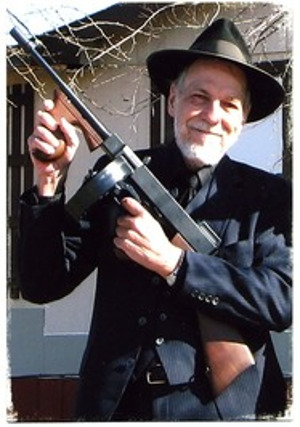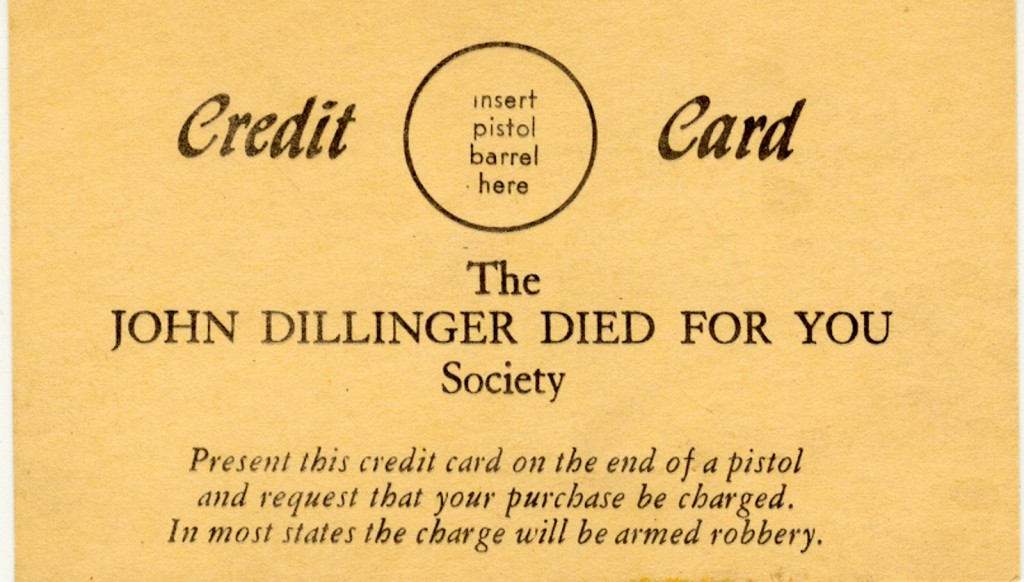
In the meantime, Bill shared this essay with us on the origins of the John Dillinger Died For You Society.
—Adam Gorightly
THE
JOHN DILLINGER DIED FOR YOU
SOCIETY
There I was, at The University of Texas, one evening in the summer of 1966, delivering a brilliantly-researched paper to a small but select American Studies class. They were spellbound by my argument that John Dillinger made a few unorthodox withdrawals from banks and therefore deserved much of the credit for improving their security at a time when Americans desperately needed a “People’s Bandit” to distract them from their Depression worries. (The fact that I also brought to class a modified tenor sax case containing a slightly-illegal Thompson submachine gun, for “show and tell,” fascinated everybody.) (You could get away with such things back then.)
As I pointed out, Dillinger had just the right style–a sense of humor, occasional pranks, treated his hostages like guests (he tied the Racine bank’s Mrs. Patzke to a tree with a shoe string), eluded every police and FBI trap, and when he broke out of the Crown Point, Indiana jail with a wooden pistol, he took a couple of happy hostages and motored out of town singing “Git along, li’l doggie, git along.”
He also was a ladies’ man—playful and romantic—until that terrible night on July 22, 1934, after he, his new girlfriend, and the duplicitous “Woman Red,” had enjoyed “Manhattan Melodrama” at Chicago’s Biograph Theatre. As they were leaving, a bunch of trigger-happy Feds set his spirit free.
(The fact that they also winged two bystanders is rarely mentioned.)
John died with his boots on, so to speak. He previously had stayed up nights nursing his girlfriend (who was ignorant of the plot) after she was banged up in a car wreck. My very own Aunt Meta was a student nurse at Cook County Hospital at the time, and she wrangled her way into the basement Cool Room to see his remains. The next day, despite the city’s hundred-plus heat wave, nearly a thousand Chicagoans patiently waited in line outside the morgue, where they were allowed to file past John’s bullet-ravaged body. Some no doubt wept. And what with the usual odors, the stench of formaldehyde, and the flies attracted to his terrible wounds, this may well have been the inspiration for what now is called “A Taste of Chicago.”
Back in 1966, however, when that particular college class had adjourned to the back-yard area of Austin’s historic Scholz Garten, our Pulitzer Prize-winning professor, Dr. William Goetzmann, after quite a few beers, proposed that we establish The John Dillinger Died For You Society. It was intended to be no more than a spoof of the Elvis Presley fan clubs that were springing up everywhere (and of the “Jesus Died For You” signs that were coming into flower), so you can imagine the enthusiasm that my Dillinger paper inspired among the other students, who also were chuckling over the Presley fan clubs and weary of hearing how anybody “died for you.”
By then Dr. Goetzmann was tipsy enough to further declare that the Society’s founder should be Horace Naismith, a mythical figure who would delegate his authority to me. That name, Horace Naismith, came out of nowhere, but it could easily be mistaken for the fellow who invented basketball. (I don’t believe anybody thought of that at the time, but it later would come in handy: “Naismith? Wasn’t he the guy who…”)
We soon had a few dozen more-or-less official members of the Society and had membership and credit cards printed, but it was not what you’d call a formal organization, like the American Legion or Rotary Club. Everyone in the Society was automatically an Assistant Treasurer authorized to sell memberships to anyone at any time for any amount and then keep it, Because John would have wanted it that way.
The “credit card” had a hole at the top and read simply, “Present this card on the end of a pistol and ask that your purchase be charged. In most states the charge will be armed robbery.”

Also, anyone in the Society could convene a meeting at any time, so long as they left one chair empty for the “Dear Departed Member.” (This would be Mr. Dillinger, of course, although some believed that it referred to his supposedly impressive Private Member, which the Smithsonian still insists it doesn’t have and refuses to display.)
In any case, we had our first official meeting at my residence (a one-time Elks Lodge) on East 12th Street in Austin, diagonally across from the state capitol, after which we amused ourselves with a little target shooting in the basement. Soon after that we instituted what we called The John Dillinger Died For You Society Picnic & Punitive Expedition which included a Thompson submachine gun, a case of ammunition, a case of beer, and a case of dynamite, because our host (who had a ranch west of Austin) was big into blowing things up.
As word got around, the Society grew until it could boast some forty or fifty members, and it had become international (I think we had one member in Canada) by the time I moved to Chicago in 1969, where John had fallen. There I encountered other Dillinger buffs (they just didn’t have a society), including two fellow Playboy employees—Bob Shea and Bob Wilson, who just happened to have offices on either side of mine—and were hard at work on Illuminatus!, which ultimately became a cult classic. (Shea would write a chapter that involved conspiracies within conspiracies and then turn it over to Wilson, sight unseen, who would take up the story and elaborate with even more conspiracies. Oddly enough, it held together and actually made sense!)
Needless to say, Shea and Wilson were both Dillinger enthusiasts because of their frequent patronage of the Biograph, and of course I helped them work Dillinger into their story. (Shea and Wilson even mentioned Dr. Naismith as something or other, and me, as the Reverend Mr. Helmer, although the rascals gave me a social disease.)
At the time I was endeavoring to give the magazine its “redeeming social value” by way of the Playboy Forum, which published letters and editorials, and the Playboy Defense Team, with offices in the Playboy Building at 919 North Michigan Avenue (formerly the Palmolive Building); and I fed Shea and Wilson enough Dillinger lore that we soon had not just one but seven Dillingers, thanks largely to a couple of goofy crime-writers who had just co-authored Dillinger: Dead or Alive? (It was our belief that since Mr. Dillinger had been accused of robbing banks all over the country, sometimes simultaneously, he therefore had to employ doppelgängers.)
Meanwhile, I kept encountering more Dillinger buffs, and after a while we began commemorating the passing of John every July 22 at the Biograph Theatre. The management even (grudgingly) cooperated, and that was how I met Richard Crowe, fabled Ghostbuster (I call him), whose several-times-a-week bus tours include Resurrection Mary, Al Capone’s old Lexington Hotel, and, of course, the alley down which the spirit of John Dillinger still walks.
Horace Naismith remained the mysterious master of ceremonies, usually masquerading as an equally mysterious Bill Helmer who maintained an eerie silence, wore a vintage straw boater, steel rim glasses, a pin-striped jacket, and an outrageous 1930s necktie. Mr. Crowe took over the Society, arranging for members (and anybody else) to meet at a nearby tavern and drink themselves into what we’ll call a wake. About 10 PM he would lead his congregation across Lincoln Avenue to the Biograph Theatre (that’s how they spell it) to hear an inspirational speech, after which Mr. Crowe would again lead the way to the nearby alley, accompanied by an honest-to-God, properly-kilted, bagpiper skirling the mournful strains of “Amazing Grace.”
Then everybody (everybody who could remember the words) joined the piper in that sad song because—we again have to presume—John would have wanted it that way.

I, under the nom de guerre Horace Naismith, have since “passed the torch” of The John Dillinger Died For You Society to Mr. Crowe, commonly known as Col. Richard Crowe. I am confident that the faithful will continue to pay their respects every July 22, commemorating the most colorful outlaw of the 1930s who never personally killed anyone.
Well, maybe one, but the cop had refused Dillinger’s admonition to stop bouncing slugs off his bulletproof vest–if it was in fact John, for he only was accused, but never had time to stand trial. In any case, he shot low, they say, and as the officer fell, one slug stuck him in the chest. When John himself later was killed, shot in the back, his pockets yielded a mere $7.71, no doubt because some $20,000 in “git” money had been stolen from his pocket by a rogue cop from East Chicago who had set up the shooting because he had been getting it on with Ana Sage, our “Woman in Red.” (Ana later confirmed that she had seen John count out the money at her place before they went to the movie).
Let’s all remember that Mr. Dillinger was crooked but not twisted, and that he disapproved of unnecessary violence. Unfortunately, he had some colleagues who did not share his otherwise conventional (if somewhat flexible) Family Values.
Remember:
BUT IT CAN BE A SHORTCUT TO IMMORTALITY
William J. Helmer, 1992
5 replies on “The Bizarre Origins But Otherwise True History of The John Dillinger Died For You Society”
I love these old parables about family values andReal American Culture! They always bring a tear to my eye…..3
I want to join the John Dillinger Died for You List.
Dillinger is by far the greatest spiritual figure because he not only died for our sins, but he sinned for our sins as well.
Illuminatus! says that on that hot summer night Simon Moon’s mother was working late at the Wobbly office on Halsted, heard gunshots, and went down the back stairs and to the corner of the alley and saw the crowd gathering around Dillinger’s body.
The description of the location is totally real.
I distinctly remember Frank (Glass Inferno) Robinson’s office being between Wilson’s and Shea’s. Although from a couple of years later.
I don’t think I have bit rot . . .